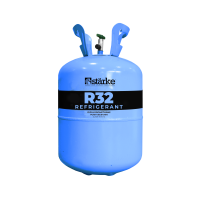| |||
| Names | |||
|---|---|---|---|
| Preferred IUPAC name
Difluoromethane[1] | |||
| Other names | |||
| Identifiers | |||
3D model (JSmol)
|
|||
| Abbreviations | HFC-32 R-32 | ||
| 1730795 | |||
| ChEBI | |||
| ChEMBL | |||
| ChemSpider | |||
| ECHA InfoCard | 100.000.764 | ||
| EC Number |
| ||
| 259463 | |||
| MeSH | Difluoromethane | ||
PubChem CID
|
|||
| RTECS number |
| ||
| UNII | |||
| UN number | 3252 | ||
CompTox Dashboard (EPA)
|
|||
| |||
| |||
| Properties | |||
| CH2F2 | |||
| Molar mass | 52.024 g·mol−1 | ||
| Appearance | Colourless gas | ||
| Density | 1.1 g cm−3(in liquid form) | ||
| Melting point | −136 °C (−213 °F; 137 K) | ||
| Boiling point | −52 °C (−62 °F; 221 K) | ||
| log P | -0.611 | ||
| Vapor pressure | 1,518.92 kPa (220.301 psi) (at 21.1 °C [70.0 °F; 294.2 K]) | ||
| Hazards | |||
| GHS labelling: | |||

| |||
| Danger | |||
| H220 | |||
| P210, P377, P381, P403, P410+P403 | |||
| NFPA 704 (fire diamond) | |||
| 648 °C (1,198 °F; 921 K) | |||
| Safety data sheet (SDS) | MSDS at Oxford University | ||
Except where otherwise noted, data are given for materials in their standard state (at 25 °C [77 °F], 100 kPa).
| |||
Difluoromethane, also called difluoromethylene, HFC-32 Methylene Fluoride or R-32, is an organic compound of the dihalogenoalkane variety. Invented in 1964 by Hoechst AG (not Daikin) it has the formula of CH2F2. It is a colorless gas in the ambient atmosphere and is slightly soluble in water, with a high thermal stability.[2][failed verification] Due to the low melting and boiling point, (−136.0 and −51.6 °C [−212.8 and −60.9 °F; 137.2 and 221.6 K] respectively) contact with this compound may result in frostbite.[2][failed verification] In the United States, the Clean Air Act Section 111 on Volatile Organic Compounds (VOC) has listed difluoromethane as an exception (since 1997) from the definition of VOC due to its low production of tropospheric ozone.[3] Difluoromethane is commonly used in endothermic processes such as refrigeration or air conditioning.

- ^ "Difluoromethane - Compound Summary". The PubChem Project. US: National Center of Biotechnological Information.
- ^ a b "Editorial Board". Journal of Fluorine Chemistry. 241: 109706. January 2021. doi:10.1016/s0022-1139(20)30404-8. ISSN 0022-1139. S2CID 243320092.
- ^ "Stratospheric Ozone Protection: The Montreal Protocol and Title VI of the Clean Air Act Amendments of 1990". Air & Waste. 43 (8): 1066–1067. August 1993. doi:10.1080/1073161x.1993.10467184. ISSN 1073-161X.


